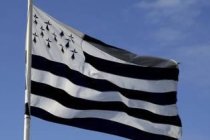Kannerezed noz – The Washerwomen of the Night in the Celtic mythology of Brittany

In the Celtic folklore of Brittany there are many creatures of the Otherworld, that mystical land occupied by spirits and deities who are rarely seen by humans. Many of these supernatural beings are benevolent and only deem to appear when and if absolutely necessary. Others simply want to be left alone to exist in the way that they have for thousands of years, long before the time of humankind. For some their role is to protect the environment and try and control the most damaging excesses of man. There are those who will deliberately seek out and help humans who care for the land of Brittany, cherish its ancient borders and protect its ancient traditions. However, amongst all of these creatures there are some who will, if encountered, be a harbinger of doom. They are to be avoided at all costs.
Amongst these darker entities of Breton mythology is the tall, skeletal, foreboding figure of Ankou. Dressed in black, carrying a scythe, he is accompanied by a cart pulled by black horses. Ankou is a night traveller that gathers the soles of the newly dead. Then there is the Nain who guard the ancient megaliths, stone circles and cairns that are found all over Brittany. Their faces are demon like with horns upon their head and their eyes are a glowing red. Dancing around the ancient stones and monoliths of Brittany they chant out the days of the week ‘dilun, dimerzh, dimerc'her, diyaou, digwener', but not the days of ‘disadorn and disul’ for these two days are held as sacred to the fairies. The night of ‘dimerc'her’ is their special night though, particularly the first one of the month of May. Ill fortune will befall those humans that should chance across and interrupt their ceremonies.
Amongst the shadowy figures of Breton mythology is the kannerezed noz. They are said to be three old washerwomen who can sometimes be seen at the side of rivers, pools or lakes. Wherever it possible to undertake their perpetual work of washing. They appear at midnight and they are said to be washing the shrouds of those who are about to die. If you have the misfortune to see these creatures, described as being dressed in green with webbed feet, then it is an omen of your own death or of someone close to you. Ignore them if you can and do not listen as they implore you to help them with their endless task of washing. If you leave them quickly and ignore their pleas there is a chance you might survive. If you do decide to succumb to their cries for help then you will be caught up in the shrouds that they are doomed forever to wash and death will surely follow.
These washerwomen of the night have their equivalents in all of the Celtic lands: Kernow (Cornwall), Éire (Ireland), Alba (Scotland), Mannin (Isle of Man), Breizh (Brittany) and Cymru (Wales). Few who have met them have survived to tell the tale. An image can be seen in the 1861 painting of ‘The Washerwomen of the Night’ by Breton artist Yan’ Dargent.
Content type:
- Breton
Language:
- English
- Log in to post comments





